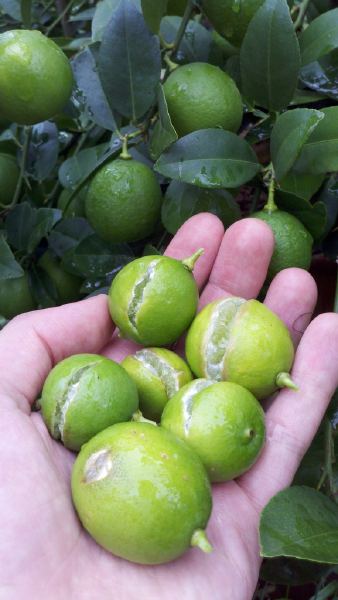The seemingly spontaneous splitting that occurs in citrus fruits,
is discouraging. Splitting is an abiotic
disorder, that is, it is a problem that cannot be attributed to any living
organism, such as an insect or plant pathogen, but one that stems instead
from environmental or cultural conditions. There is no chemical control for
this physiological condition. The split usually starts at the weakest pint in the rind. Splits probably occur when water and sugar are transported from the roots of the tree to the ripening fruit, and the rind is unable to expand quickly enough to accommodate the added volume. The rind burst open under the pressure. Some citrus varieties, especially thin skinned ones, may be more likely to split than other varieties. Rinds that have been sunburned or otherwise damaged may be less elastic than normal and therefore more apt to split. Although the exact cause is unknown, fruit splitting is likely the result of stress to the tree. Splitting appears to be most closely related to extreme fluctuation in temperature, humidity, soil moisture, and possibly fertilizer levels, and the disorder is probably caused by a combination of these factors rather than by a single cause. For example, when hot weather is combined with high
winds, the tree becomes drought stress and begins to take water from the
fruit, causing the fruit to soften causing it to crack. Young trees or dwarf
varieties with relatively small or shallow root systems as with trees in containers that are to small for the size of the tree, as well as trees
grown in very sandy or porous soils that do not retain moisture well, may be more susceptible. to fruit splitting. Reasonable cultural practices to avoid extreme fluctuations in soil moisture and fertilization levels throughout the growing season may help to minimize fruit split. Trees should be irrigated regularly to assure a continuous supply of soil moisture, especially during hot or windy weather. When hot winds are anticipated, irrigate before the winds begin. After the hot winds subside, irrigate lightly for a few days and then resume a normal irrigation schedule. Instead of a single large application of quick release fertilizer each year, smaller monthly applications throughout the growing season may help keep nutrient levels constant. Timed release fertilizers offer the convenience of supplying nutrients at an even rate over the length of the growing season, but they are usually more expensive than other fertilizers. - Millet (480-)













